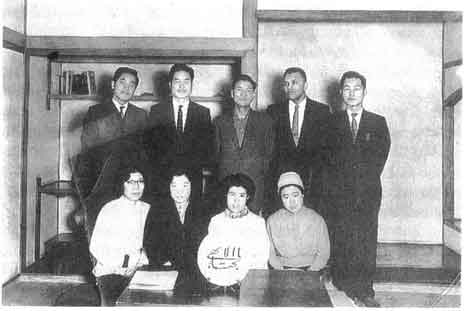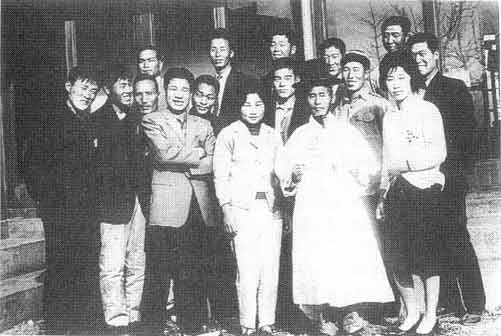
|
Raising the Banner in Korea:
An Early Bahá'í History
by Barbara R. Sims
 |
chapter 9 | start page | single page | chapter 11 |  |
Chapter 10
10. The Early 1960s
In April 1960 there were five Local Spiritual Assemblies: Seoul (first elected 1956); Kwangju (1956); Mokpo (1958); Chunju (1959); and Pusan (1960). There was a reported total of 75 Bahá'ís which included six pioneers: Mr. Smits, Mr. Maxwell, Mr. McHenry III, Mr. and Mrs. Enger and Sgt. Roy MacDonald.A report was sent to Hand of the Cause Miss Alexander in early 1960 telling of the teaching activities for several months. In April Mr. Kim Chang-zin went to Pusan from Suwon where he was then living. He spoke at one of Pusan's regularly scheduled meetings. The Board member described Mr. Kim's "humility, his gracious manner, his wide though unpretentious knowledge and his simple dignity." This man, who had waited for so many years to have contact with the Bahá'í community, made a deep and lasting impression on those who knew him.

click for larger image
The First Local Spiritual Assembly of the Bahá'ís of Pusan, elected 1960. Seated: Mr. Ko Han-joon (treasurer), Mrs. Lee Gap Sun, Mrs. Barbara Enger, Mr. Suh Byong-in (chairman) and Mr. Shin Yong-ho. Standing: Mr. Jun Yong-gap, Mr. Dale Enger (secretary), Mr. Kim Byung-ho and Mr. Oh Jung-yong. (When the present writer visited Korea in 1995 she was happy to meet Mrs. Lee who has been an active and steadfast promoter of the Faith through the years.)
Members of a study class in the village of Yongsanri, Hanpyung-kun (Hanpyung county) in 1962. Mr. McHenry and Mr. Im Won Taek are at the right. Mr. Im had finished his education at Kwangju and returned to his native area to teach the Faith. Soon there were over 25 Bahá'ís and they formed the Local Spiritual Assembly of Haebo, which included this village.

click for larger image
A Teaching Conference in Kyongju, December 29-30, 1962. The conference was opened by the mayor of the town visiting the newly acquired Bahá'í Center. There was such enthusiasm that nineteen adults and one youth enrolled in the Faith during this conference which was the culmination of weekend teaching during the last four months of the year.

click for larger image
A meeting in Kyongju, the ancient capital of the Silla Kingdom, October 21, 1962, celebrating the Birth of the Báb. Mr. Lee Yun-sup is translating for Mr. Maxwell. This meeting attracted about 40 people. Mr. Lee and Mr. Maxwell went to Kyongju for teaching every weekend during the last months of the year.
A report written in early 1961 lists 97 believers, five Local Spiritual Assemblies (the same as elected in 1960), three groups and two isolated Bahá'ís.
The next year, 1962, it was reported that Bahá'ís resided in 29 localities, including areas which had Local Assemblies. Teaching activity seemed to be widespread. Taegu now had more than 60 new believers. Praise was given to the youth for their teaching: Mr. Im Won Tack was a high school student who taught the Faith to his friends in the farm village of Chakungsung-mae; and Mr. Pak Chong-kyo, also under 21, "who worked hard to reestablish the LSA in Chunju". The development of the Local Spiritual Assembly in Iro on the island of Koha was assisted by Mr. Kim Chae-kwon. Mr. Ahm Chull Soon made several trips from Mokpo to help with the teaching. Ten Bahá'ís were listed in Chunju that year with half being women.
A report sent to the National Spiritual Assembly stated that during a teaching conference in Kyongju twenty persons enrolled in the Faith, December 30, 1962: nineteen adults and one youth. It was the largest number of people to accept the Faith in one day. The conference was opened by the mayor of the city visiting the newly acquired Bahá'í Center. The conference and subsequent enrollments were the result of weekend teaching over the four months previous. An enrollment ceremony was conducted by Mr. Kim Chang-zin and Mr. Suh Byong Im on behalf of the National Teaching Committee. The report said "many of these new believers are important civic and cultural leaders in this city."
The total number of Bahá'ís in Korea stood at 250, with some other figures mentioned: Hosa 9; Kaji 14; Koba 36.
During the next few months as the mass teaching started these figures were to be exceeded.
After 1962 it is difficult to give a complete, or more detailed, account of the progress of the Faith in Korea as it was growing in all directions. But perhaps it is interesting to mention that at that time the youth were becoming very active and much of the teaching was no longer in the hands of the pioneers. The three long-term pioneers, Maxwell, Smits and McHenry III, had been the primary teachers through the years. As they traveled with Korean Bahá'ís, the Koreans gained in knowledge and experience and became teachers on their own. It is also to be noted that, although some Korean women became Bahá'ís, they did not come into the Faith in the early days in the numbers that happened in some other countries. Perhaps a reason was that the pioneers and Koreans who traveled with them were all men.
In 1953 at the beginning of the Ten Year Crusade there was only one Local Spiritual Assembly in North East Asia: Tokyo. By 1957, in addition to other areas in Asia, there were two Local Spiritual Assemblies in Korea: Seoul and Kwangju. By the end of the Ten Year Crusade,
Ridván 1963, there were twelve Local Spiritual Assemblies in Korea, which had been elected at Ridván the previous year: Seoul, Kwangju, Haebo, Iro, Kajo, Kochang, Mokpo, Namhae Is., Pusan, Samho, Suwon and Taegu.
In the three months just preceding the end of the Ten Year Crusade, Hand of the Cause Dr. Rahmatu'llah Muhajir arrived in Korea and helped the community formulate a plan which had the objective of enrolling 1,000 believers in two months. The goal was exceeded during the first month and by Ridván, which was the end of the Crusade, 1,421 people had accepted the Faith. (Figures vary somewhat depending upon the reports as people were accepting the Faith every day in several areas.) Twenty-six Local Spiritual Assemblies were formed that Ridván, 1963; also there were five groups and 61 isolated believers. Dr. Muhajir visited Korea several times and was responsible for the community grasping the concept of mass conversion, or teaching and enrolling by groups. In January 1963 Mr. John McHenry III was appointed to the Auxiliary Board for Protection by the Hands of the Cause in Asia.
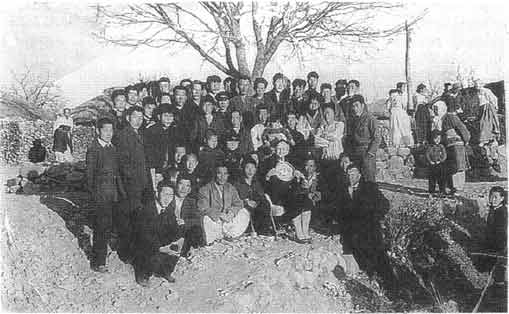
click for larger image
Hand of the Cause Miss Alexander holding a plaque of the Greatest Name, surrounded by Bahá'ís of Kajo village in March 1963. At least three members of the Local Spiritual Assembly of Kajo can be seen in the photo. Mr. Maxwell is standing below to the right.
The first Local Spiritual Assembly of the Bahá'ís of Taegu, 1963. Front: Miss Pak Ok Soon, Miss Chung Chong Jin, Miss Kim Chom Soo and Miss Chang Mal Hyang. Standing: Mr. Lee Yoon Sup, Mr. Kim Yong Tae, Mr. Dho Jae Kwon, Mr. William Maxwell and Mr. Pak Sam Bong. In November of the following year Miss Pak and Mr. John McHenry III were married.

click for larger image
The first Local Spiritual Assembly of the Bahá'ís of Kajo Village, 1963. Unfortunately we do not have the names of these Bahá'ís. According to an article sent from the Bahá'ís in Korea to the Japanese Bahá'í News, Kajo was the first all-Bahá'í village in Korea, with a population of a little under 1000.
Hand of the Cause Agnes Alexander visited Korea in 1963. She wrote that she
received a phone call from Mr. Maxwell asking her to come for a few days. She
visited Kajo village, which, she wrote, had the privilege of being the first
Bahá'í village in Korea. She had a meeting with the women and
gave each of them a photo of the painting of 'Abdu'l-Bahá by Juliet
Thompson. She visited the Kyongju Bahá'í Center, the Pusan
Bahá'ís and returned to Seoul. She wrote that it was her fifth
visit to Korea. It was to be her last.
In 1963 the historic first election of the Universal House of Justice took
place in Haifa, Israel. Soon after, the first World Congress took place in
London. Two Korean Bahá'ís attended the London Congress: Mr. Kim
Chang-zin, who had been invited to attend by the National Spiritual Assembly of
North East Asia, and Mrs. Lee Whasung (Yi Hwa-song) Smits, whose marriage to
William Smits the previous year was the first between a Korean
Bahá'í and an American Bahá'í.
That year Mr. and Mrs. Maxwell left Korea to return to the United States where he was to resume his education, receiving his doctorate.
In late 1963 there was a report given by an Auxiliary Board Member which said that Korea had over 3000 Bahá'ís and the Faith was continuing to grow due to the steadfast, devoted and self-sacrificing efforts of the friends. The report gives an example: Mr. No Byong Ka of Kwangju walked nine days to reach the Summer School held in Taegu in August and he returned on foot. He wanted to bring back the spirit to his community in Kwangju. Teacher Training Institutes were being held at regular intervals; three so far in 1962/63. The teachers then went back to the villages to do mass teaching and consolidation.
On December 10, Human Rights Day, the Faith was proclaimed on an international overseas broadcast, with Dr. David Earl speaking. A report states that it was the first public proclamation in several years.
In preparation for the coming election of the first National Spiritual Assembly of the Bahá'ís of Korea, in 1963 a large committee of the most active Bahá'ís was appointed, called the National Administrative Committee, whose duty it was to assume the affairs of the Faith in Korea. The first appointment consisted of the four American pioneers then in Korea and nine Korean Bahá'ís. It prepared the community for the election the following year. The Faith in Korea was growing daily and the National Spiritual Assembly of North East Asia, based in Tokyo, could hardly keep up with the increasing changes.
One decision of the new Administrative Committee was to officially start the Korean Wolbo newsletter. Mr. Yang Jae-ho was the editor of the
new Wolbo which was printed every Bahá'í month. At first it was four mimeographed pages. The committee wanted to print 500 copies but reduced this to 300 because of the expense. Although this was the first official Wolbo, back in 1956 there were two mimeographed editions of the Wolbo, one from Kwangju and the other from Seoul, printed for distribution among the friends. They contained deepenings, international news and local news. The Japanese Geppo newsletter had been sent to Korea as many people could read Japanese. In 1959 and 1960 there was reference to a Wolbo which Mr. Kim Chang-zin translated from Japanese; perhaps adding local news. He sent the manuscript to Mr. Yang Hyo Jong of Mokpo who printed and mailed it to Bahá'ís throughout Korea. By January 1960 issue #71 was sent out indicating that it had been issued for some time.
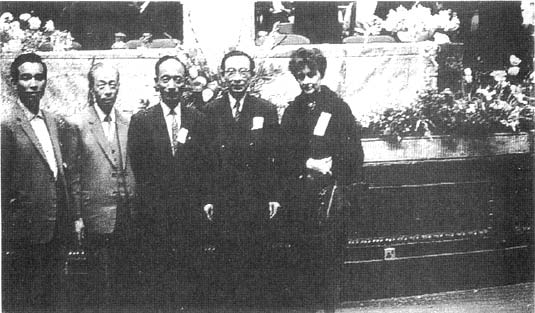
At the London Congress, 1963. Mr. Kim Chang-zin (middle) was invited to attend by the National Spiritual Assembly of North East Asia as a representative from Korea. Others are from Japan: Auxiliary Board Member Mr. Michitoshi Zenimoto, and three members of the National Assembly, Dr. Ikuo Mizuno, Mr. Masazo Odani and Mrs. Barbara Sims. Mrs. Sims (the present writer) was a pioneer to Japan. Mr. Kim conversed with the friends from Japan in fluent Japanese.
As the Faith continued to grow, teacher training institutes were started. This was one held in Seoul, in 1963. After attending the institute the teachers would go out to other areas to teach and deepen.
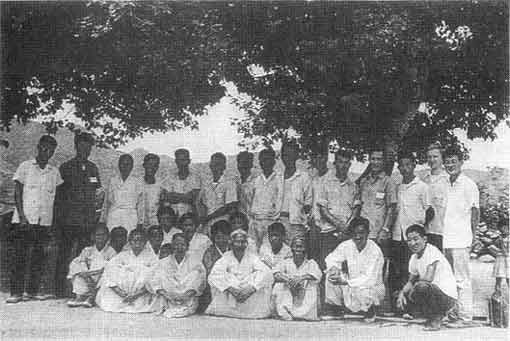
click for larger image
After attending a Teaching Institute, the Bahá'ís went to Changchong village to spread the Faith. Here are some of the participants.
 |
chapter 9 | start page | single page | chapter 11 |  |
|
|

